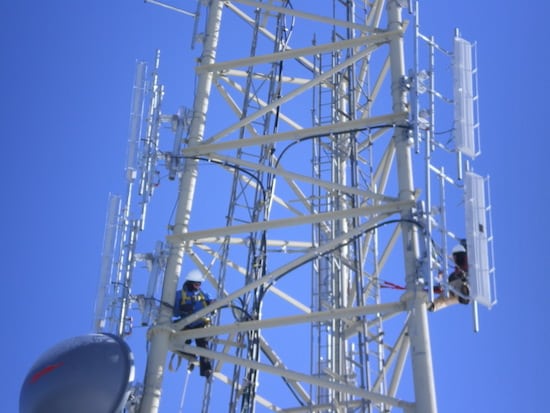
An in-flight connectivity network tower operated by Gogo. Photo courtesy of Gogo
No specific plans or timelines have been announced about the coalition of companies aimed at driving down the price and up the availability of in-flight connectivity of Sprint, OneWeb, Airbus, Delta and Barti Airtel, which joined forces in February as the “Seamless Air Alliance.”
During an in-flight connectivity panel discussion at the Satellite Show 2018, Gogo’s CTO said that the details about the alliance will eventually become clearer, but did not expand beyond that.
The goal of the Seamless Air Alliance is to leverage each member’s strengths — such as Sprint’s current 4G and eventual 5G network, and Airbus and Delta’s buying power in their respective parts of the market — to effect the goals of available data access without the exorbitant cost of entry.
The members include a prominent provider of air-to-ground cellular service in Sprint, and also OneWeb, an ambitious global communications company who describes itself as world’s fastest satellite production facility. OneWeb wants to build 900 satellites that it said will eventually orbit the earth and provide 3G, 4G and 5G satellite connectivity at affordable prices to end users of all kinds on devices equipped with smaller and leaner user terminals.
Another panel focusing on 5G networks discussed the potential convergence of the satellite and terrestrial industries. Speakers on the panel asserted that establishing fair and open-ended standards will be key for satellite to operate in parallel with cellular networks for joint use cases.
One of the satellite industry’s biggest mistakes in the past was that companies were too slow to react to the 4G era. As a result, the industry was unable to capitalize on the opportunities incumbent in the generational leap from 3G to 4G connectivity.
“We did get a piece of the pie of 4G with backhaul … but our cash cow in the past 10 years has been video. We didn’t realize that when 4G came, the shift in consumer behavior would turn our industry upside down on the video side,” said Nile Suwansiri, chief commercial officer of Thaicom. “With 5G, we have an opportunity now to be a little smarter.”
With the missteps of 4G top of mind, satellite companies have been much more vocal about the standards they need to succeed once the 5G wave crests around 2020.
“It’s about making sure the standards at a higher level and the overall architecture are such that when you want to slot in satellite as a solution for connectivity in a given use case … the standards allow you to do that,” said Ethan Lavan, Eutelsat’s director of in-orbit resources.
If at all possible, the industry must avoid a situation where a satellite link would be perfectly suited, but the standards are too closed to accommodate the network, Lavan said.
Kalpak Guide, president of the Dynamic Spectrum Alliance, agreed that satellite must move away from the backhaul focus to maintain its revenue streams. If not, “the margins will continue to erode,” he said. “If you own the customer — if you own that last connectivity piece — that’s where the drive is. That’s the hardest part in practical terms for satellite.”
Coincidentally, as satellite seeks new opportunities outside of backhaul, mobile operators are hoping to expand beyond their typical connectivity services, said Jefferson Wang, Accenture Strategy’s managing director of communications, media and technology. The profit pools for each are just too small to be sustainable; thus, the traditional territories of both cellular and satellite companies will begin to overlap as the industries hunt for new profitability beyond their borders.
When it comes to 5G specifically, Gude pointed out that it being a “network of networks” necessitates a combination of technologies, services and service providers. “The [mobile] carriers are going to be central to it, but I do not believe they will be alone in providing what that 5G network looks like,” he said.
“We’re not going to be the biggest part of the network for 5G but there are areas we can complement, such as … mobile edge computing, where you want the data to be as close as possible to the end user,” Suwansiri added.
5G Internet of Things (IOT) applications is another area of particular interest for satellite operators. One of satellite’s historical disadvantages is the latency associated with transmitting data from geosynchronous-Earth obit. However, because bandwidth capacity is one of the biggest limitations for IOT, not low latency, satellite is a perfect fit for that use case, said Lavan. This gets to the heart of what 5G is about. No one claims they’re going to provide global 5G coverage — rather, 5G will unlock new use cases in existing markets due to its enhanced speed and ability to accommodate many more devices, Wang said.
To ensure satellite gets a satisfactory piece of the pie, operators need to be willing to work alongside cellular networks in these markets instead of deliberately avoiding them, Suwansiri suggested. This is true for 5G in large cities, as well as mobile applications including the connected car. “If all we’re thinking about is where fiber doesn’t go, it’s not a sustainable business model,” Suwansiri said. A better question for satellite operators to ask themselves is how they can remain relevant even in regions where fiber exists.
It follows, then, that iDirect Chief Executive Officer (CEO) Kevin Steen predicts we will “absolutely” see cellular-satellite hybrid terminals in the near future. “The responsibility falls onto someone like me,” he said, speaking from the perspective of a ground systems manufacturer. “My job has to be to enable. Because if I can’t move faster and make it happen I’ll be a roadblock.”
This article was first published in Via Satellite, a sister publication to Avionics. It has been edited.